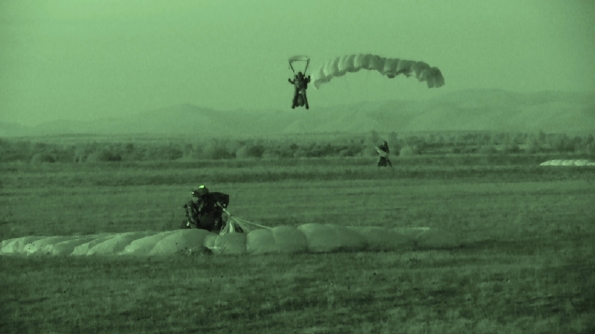- Home
- 'Boletín Tierra' Newspaper Reports
- Full article
Paratroopers and Special Operations personnel, specialised in high-altitude parachute insertion
Monday, November 23, 2015
Number: 4713
Jumpers experienced in manual opening from the Parachute Brigade and Special Operations Command took part in a HALO-HAHO course – the first of its kind – which ran from 3 to 13 November, in order to become specialized in high-altitude parachute insertion.
The participants had to prove that they had made at least 75 jumps and pass a medical examination at the Aerospace Medicine Research Centre in order to be admitted to the course, which was taught by personnel from the Paratroopers Unit (ULANPAC in its Spanish acronym) of the 6th Parachute Logistic Group.
The first week took place at the facilities of ULANPAC and was devoted to theoretical training. The focus was on simulated flights. In these sessions the jumpers were equipped to jump and went through the procedures to be carried out inside the aircraft, simulating possible incidents they may have to confront in a real-life situation. This phase concluded with a test of the knowledge acquired.

Jump made during the course (Photo: BRIPAC)
The second week was devoted to practical exercises and took place at the Air Base of León, and a total of eight high-altitude jumps with oxygen equipment were made. Altitude was gradually increased from 18,000 feet (6,000 metres) to 24,500 feet (8,000 metres) and the two jumping techniques, HALO and HAHO, were alternated.
In the HALO technique the jumpers leave the aircraft near the designated drop zone, free-fall for a period of time and then open the parachute at 5,000 feet (1,500 metres). When using this technique, they experience a significant change in pressure. In contrast, in the HAHO technique the parachute is opened right after leaving the aircraft, which allows the jumpers to travel great distances. During the time the jumpers are in the air they face temperatures of around -20ºC, and therefore require special clothing to prevent frostbite.
ARMY UNITS
- Araba Álava |
- Albacete |
- Alicante |
- Almería |
- Asturias |
- Ávila |
- Badajoz |
- Barcelona |
- Burgos |
- Cáceres |
- Cádiz |
- Cantabria |
- Castellón |
- Ceuta |
- Ciudad Real |
- Córdoba |
- A Coruña |
- Cuenca |
- Girona |
- Granada |
- Guadalajara |
- Gipuzkoa |
- Huelva |
- Huesca |
- Islas Baleares |
- Jaén |
- León |
- Lleida |
- Lugo |
- Madrid |
- Málaga |
- Melilla |
- Murcia |
- Navarra |
- Ourense |
- Palencia |
- Las Palmas |
- Pontevedra |
- La Rioja |
- Salamanca |
- Segovia |
- Sevilla |
- Soria |
- Tarragona |
- Santa Cruz de Tenerife |
- Teruel |
- Toledo |
- Valencia |
- Valladolid |
- Bizkaia |
- Zamora |
- Zaragoza



